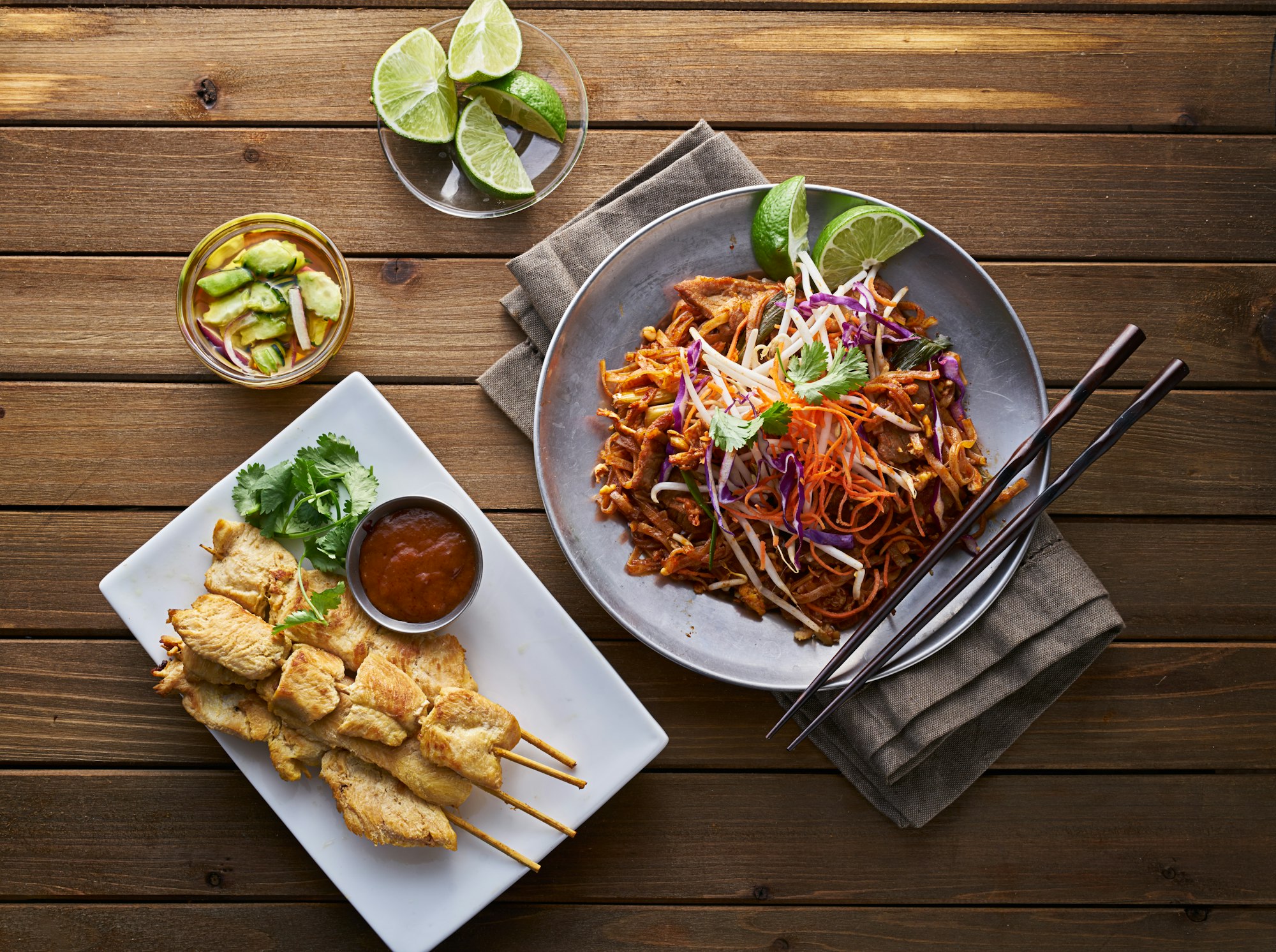If you are fans of Thai cuisine, you will certainly know the joy of a well-made Pad Thai. This national dish of Thailand is a crowd-pleaser around the globe; a bowl of stir-fried rice noodles tossed in a tangy, sweet, and savory sauce, garnished with crunchy peanuts, and served alongside fresh lime wedges.
It’s not just about the noodles, though, as the heart and soul of a Pad Thai is undoubtedly the sauce. The tamarind-based sauce is the key to getting the traditional Pad Thai flavor. This guide will instruct you on how to create a flavor-packed Pad Thai with Tamarind Sauce, focusing on the ingredients and the step-by-step process.
Lire également : What’s the Key to Perfectly Crispy Korean Bibimbap in a Stone Bowl?
Decoding the Ingredients
The exotic and robust flavor of Pad Thai comes from the careful blend of unique ingredients. Let’s take a look at them.
Tamarind
This is the star of the show. Tamarind paste gives Pad Thai its characteristic tangy and slightly sweet flavor. It’s made from the pulp of the tamarind fruit, a tropical tree native to Africa.
Cela peut vous intéresser : How to Bake a Strawberry Frangipane Tart with a Buttery Pastry?
Rice Noodles
Thick rice noodles are the traditional choice for Pad Thai. They are gluten-free and have a lovely tender-chewy texture when cooked just right.
Proteins
Typically, you will find chicken, shrimp, or tofu in a Pad Thai. You can choose according to your preferences.
Seasoning
Fish sauce, palm sugar, and lime juice are the other main flavors in the sauce. Fish sauce imparts a salty-umami note, palm sugar balances with sweetness, and lime juice adds a zesty freshness.
Fresh Ingredients
Garlic, shallots, and red chili flakes are sautéed in oil to release their aroma and flavor. Bean sprouts and green onions add crunch.
Exploring the Traditional Pad Thai Recipe
Now that we have gathered our ingredients let’s dive into the recipe, which will be broken down into a step-by-step process to ensure clarity and ease for you.
Step 1: Preparation
Begin by soaking the rice noodles in lukewarm water for about 30 minutes until they are soft but not mushy. While the noodles are soaking, you can start preparing the tamarind sauce.
Step 2: Making the Tamarind Sauce
The tamarind sauce is the heart of the Pad Thai. In a small bowl, mix together the tamarind paste, fish sauce, palm sugar, and lime juice. Adjust these ingredients to taste.
Step 3: Cooking the Proteins
Heat some oil in a wok or large frying pan. Add your choice of protein (chicken, shrimp, or tofu) and sauté until they are cooked. Remove the proteins from the pan and set them aside.
Step 4: Building the Flavors
In the same pan, add some more oil, followed by the garlic and shallots. Sauté for a few minutes until they are fragrant, then toss in the red chili flakes.
Step 5: Bringing it Together
Drain the noodles and add them to the pan, followed by the tamarind sauce. Toss everything together and let it cook for a few minutes until the noodles absorb the sauce and become tender.
Finish by adding back the cooked proteins and tossing in the bean sprouts and green onions. Give everything a final good stir to make sure all the ingredients are well incorporated.
Tailoring the Pad Thai to Your Taste
One of the beauties of Pad Thai is its flexibility. You can easily tailor the dish to your taste, dietary restrictions, or what you have in your pantry.
Protein Options
Chicken, shrimp, and tofu are the traditional protein options for Pad Thai, but feel free to replace them with any protein you prefer.
Vegetarian/Vegan Alternatives
Tofu is an excellent choice for vegetarians. For a vegan version, replace fish sauce with soy sauce or tamari, and make sure to use a vegan sugar.
Add-on Ingredients
You can add other vegetables like bell peppers, carrots, or zucchini for extra crunch and color.
Tips to Perfect Your Pad Thai
Making Pad Thai might seem intimidating at first, but with a bit of practice, you can master it like a Thai chef. Here are some tips to help you achieve the best results.
Using the Right Pan
A wok is the best pan to make Pad Thai. The high, sloping sides are perfect for stir-frying, allowing the noodles to glide easily without sticking to the bottom.
The Right Heat
Pad Thai requires high heat to sear the ingredients and create a complex flavor profile. But be careful not to burn the garlic or noodles.
Sauce Consistency
Your tamarind sauce should have a balance of sweet, salty, tangy, and spicy flavors. It should be thick enough to coat the noodles but not too thick that it becomes gloopy.
Fresh Ingredients
Fresh ingredients are key. Freshly squeezed lime juice, freshly ground palm sugar, and fresh vegetables will make a noticeable difference in your Pad Thai.
Creating a flavor-packed Pad Thai with Tamarind Sauce doesn’t have to be a daunting task. With the right ingredients, a traditional recipe, and a few handy tips, you can make this Thai classic right at home. Enjoy the process and remember—the magic is in the sauce!
The Secret Behind Using Tamarind in Pad Thai
Tamarind is the ingredient that lends a distinctive sour flavor to Pad Thai. It is a tropical fruit that comes in a pod-like shell with a sticky pulp inside, used extensively in Thai and other Southeast Asian cuisines. For making the Pad Thai, we will be using tamarind paste, a concentrated form of tamarind.
Tamarind Paste vs. Tamarind Concentrate
Tamarind paste and tamarind concentrate are not the same. Tamarind paste, used in traditional Thai recipes, is a thick, sticky substance made by removing the shell and seeds from tamarind fruit, soaking the pulp in warm water and straining it. The paste is tangy and slightly sweet, with a rich flavor and a bit of texture.
On the other hand, tamarind concentrate, often found in mainstream grocery stores, is more processed, thinner, and has less flavor. If you only have tamarind concentrate, you may need more of it to achieve the desired sourness in your Pad Thai.
How to Use Tamarind in Pad Thai Sauce
The tamarind paste is used in conjunction with fish sauce, palm sugar, and lime juice to create a balanced, tangy-sweet flavor in the Pad Thai’s Thai sauce. To make the sauce, simply mix the tamarind paste with the other ingredients and adjust the sweetness, sourness, and saltiness to your liking.
Remember, the sauce shouldn’t be overly sweet or sour. The beauty of Pad Thai is the perfect balance of flavors that tantalize your taste buds.
The Garnishing Touches: Crushed Peanuts and Lime Wedges
A bowl of Pad Thai is incomplete without its famous garnishes: crushed peanuts and lime wedges. These toppings not only add a flavorful crunch but also enhance the overall taste and presentation of the dish.
Why Crushed Peanuts?
Crushed peanuts add a wonderful crunch and nutty taste to the Pad Thai. You can either lightly toast the peanuts before crushing them for an extra layer of flavor or use them raw. Sprinkle the crushed peanuts generously over your Pad Thai just before serving. This will ensure they maintain their crunch and won’t get soggy from the Thai sauce.
Lime Wedges: Not Just for Show
Lime wedges served with Pad Thai are not just for show; they play an important role in the overall flavor of the dish. The fresh lime juice squeezed over the Pad Thai just before eating adds a burst of freshness and brings out the flavors of the other ingredients. It enhances the sweet and sour notes of the tamarind sauce and balances the richness of the noodles and proteins.
Conclusion
Thai cooking is all about balance and harmony of flavors. A good Pad Thai should have a balance of sweet, sour, salty, and spicy flavors, with a variety of textures from the soft rice noodles, firm proteins, crisp bean sprouts, and crunchy peanuts. The key to achieving this balance is in the tamarind sauce. It carries the quintessential sour note in Pad Thai, balanced by the sweetness of palm sugar, saltiness of fish or soy sauce, and heat from the chili flakes.
So next time you decide to stir fry your own flavor-packed Pad Thai, remember these tips: start with quality ingredients, make sure your tamarind sauce is well balanced, and don’t forget the final touches of crushed peanuts and a squeeze of fresh lime juice. With a bit of practice, you’ll be mastering the art of making Pad Thai at home, impressing your family and friends with your culinary prowess. Enjoy this Thai staple and happy cooking!






